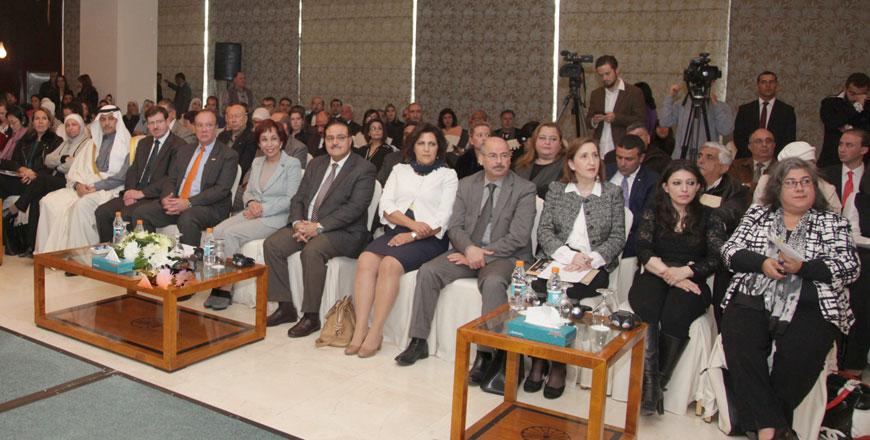You are here
When it comes to future of girls, we are all responsible — Princess Basma
By Khetam Malkawi - Dec 01,2016 - Last updated at Dec 01,2016

HRH Princess Basma attends a ceremony in Amman on Thursday to launch the World Population Report 2016 (Petra photo)
AMMAN — HRH Princess Basma on Thursday stressed the important role that society plays in shaping the futures and lives of girls.
“Let us remember that we are all responsible. Let us remember that our every word or deed, positive or negative, can affect the road [a 10-year-old girl] travels from this crossroads in her life. This is what will shape her role in society, which is to say our society, and our world,” Princess Basma said at the launch of the State of the World Population Report 2016.
The UNFPA prepared the report under the theme “10: how our future depends on a girl at this decisive age”.
The report, which focuses on the well-being of 10-year-old girls and the importance of investing in them, said 89 per cent of the world’s 125 million 10-year-old girls live in developing countries and face obstacles related to equal education, healthcare and safety.
Princess Basma said that in some parts of the world, a 10-year-old girl looks forward to her horizons opening up so she can achieve her goals.
“Elsewhere, however, she is up against closed doors. Her prospects are limited while her future is determined by others or by her harsh environment including factors threatening her safety and socioeconomic promise,” added the princess, who is also UNFPA’s global goodwill ambassador.
“In our society,” she explained, when a girl reaches the critical age of 10, and signs of maturity start to appear, “that’s when her freedom begins to erode due to a kind of social pressure”.
“She may be deprived of education or employment, or productive participation in public life. In this decisive window of time, we must see to it that she continues her education at a level of quality that measures up to international standards,” the princess continued.
This year’s State of World Population report highlights practices that harm girls and violate their human rights — starting at age 10 — preventing them from realising their full potential as adults and from contributing to the economic and social progress of their communities and nations.
Without their contribution, the United Nations Agenda 2030 for Sustainable Development and its accompanying 17 Sustainable Development Goals may never be achieved, according to the report.
Speaking at the launch ceremony, Daniel Baker, regional humanitarian coordinator and head of the UNFPA Jordan’s country office, said that today “we are highlighting the findings of a report that shows vividly how all of our futures are critically dependent on the future prospects of young girls everywhere, including here in Jordan”.
Baker highlighted that the report is all about something the UNFPA is setting out as the key to reaching the sustainable development goals in 15 years — “that is, realising the demographic dividend, of which Jordan is a prime example”.
He added that since the future of girls is “our common future”, everyone — women and men, girls and boys — should be involved in challenging gender discriminatory norms.
“This also means freedom from violence of any sort,” the UN official stressed.
Higher Education Minister Adel Tweisi also spoke about the education opportunity that Jordan provides to all, regardless of gender or religion.
He noted that the government is keen to empower all children through compulsory education, with a special focus on girls.
In Jordan, there are 72,500 girls at the age of 10, and some 31,300 Syrian girls of the same age, according to Suad Nabhan, assistant representative at the UNFPA Jordan’s office.
“We have so many girls at this age to deal with,” Nabhan said, adding that the 10-year-old girls now will be 25 in 2030, when the world will check the implementation of the Sustainable Development Goals. Thus, they are the future.
Report highlights
- Nine out of ten 10-year-old girls live in developing countries, and one in five lives in a least developed country
- Each year of education delivers an additional 11.7% uplift in wages in later life for girls (compared with 9.6% for men). Yet, 16 million girls between the ages of 6 and 11 will never start school, twice the number of boys
- If all the 10-year-old girls who drop out of school or do not attend school in developing countries completed secondary education, they would trigger a $21 billion annual dividend
- 10% of 5-to-14 year-old girls do more than 28 hours of household chores per week, twice that of boys
- Three in four girl labourers are unpaid
- Every day, an estimated 47,700 girls are married before 18
Source: UNFPA World Population Report 2016
Related Articles
Suad Nabhan, the new UNFPA Jordan assistant representative, assumed her duties on June 1, the UN agency said in a statement released Saturday.
In a country where more than 70 per cent of the population is under the age of 30, all national strategies should be crafted with an eye on investing in young people’s potentials and aspirations, experts said on Sunday.
AMMAN — HRH Princess Basma Bint Talal, long-time Goodwill Ambassador for the United Nations Population Fund (UNFPA), welcomed fellow Goodwil
















